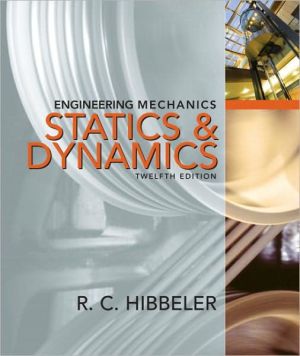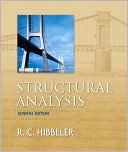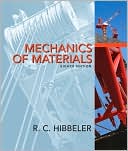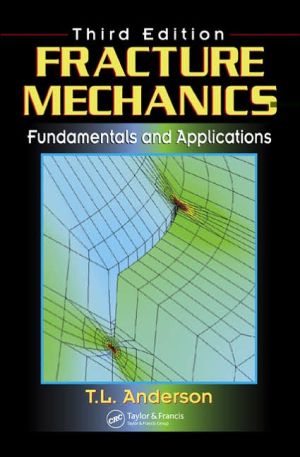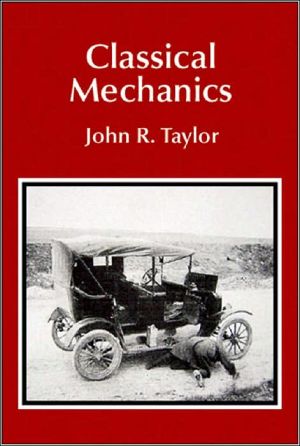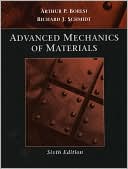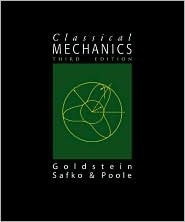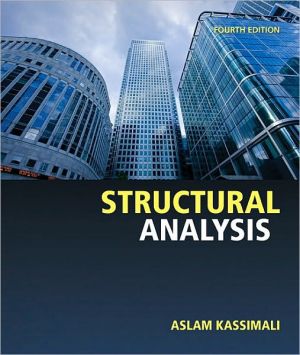Engineering Mechanics: Combined Statics & Dynamics
Engineering Mechanics: Combined Statics & Dynamics, Twelfth Edition is ideal for civil and mechanical engineering professionals. In his substantial revision of Engineering Mechanics, R.C. Hibbeler empowers students to succeed in the whole learning experience. Hibbeler achieves this by calling on his everyday classroom experience and his knowledge of how students learn inside and outside of lecture.\ In addition to over 50% new homework problems, the twelfth edition introduces the new...
Search in google:
KEY BENEFIT: R.C. Hibbeler’s text features a large variety of problem types from a broad range of engineering disciplines, stressing practical, realistic situations encountered in professional practice, varying levels of difficulty, and problems that involve solution by computer. KEY TOPICS: Maintaining the hallmark Hibbeler focus on problem-solving, visualization, and accuracy, this edition includes over 50% new problems, and new elements of Conceptual Problems, Fundamental Problems and MasteringEngineering, the most technologically advanced online tutorial system. MARKET: Ideal for civil and mechanical engineering professionals. Booknews Presents to the student the theory and applications of engineering mechanics. The author emphasizes the drawing of free-body diagrams and notes the importance of selecting an appropriate coordinate system and associated sign convention for vector components when the equations of mechanics are applied. Discussion of the subject areas of statics and dynamics covers such topics as the properties of a concurrent force system, the equilibrium and kinematics of a particle, and the planar motion of a rigid body. Annotation c. by Book News, Inc., Portland, Or.
STATICS1 General Principles 3Chapter Objectives 31.1 Mechanics 31.2 Fundamental Concepts 41.3 Units of Measurement 71.4 The International System of Units 91.5 Numerical Calculations 101.6 General Procedure for Analysis 122 Force Vectors 17Chapter Objectives 172.1 Scalars and Vectors 172.2 Vector Operations 182.3 Vector Addition of Forces 202.4 Addition of a System of Coplanar Forces 322.5 Cartesian Vectors 432.6 Addition of Cartesian Vectors 462.7 Position Vectors 562.8 Force Vector Directed Along a Line 592.9 Dot Product 693 Equilibrium of a Particle 85Chapter Objectives 853.1 Condition for the Equilibrium of aParticle 853.2 The Free-Body Diagram 863.3 Coplanar Force Systems 893.4 Three-Dimensional Force Systems 1034 Force SystemResultants 117Chapter Objectives 1174.1 Moment of a Force—ScalarFormulation 1174.2 Cross Product 1214.3 Moment of a Force—VectorFormulation 1244.4 Principle of Moments 1284.5 Moment of a Force about aSpecified Axis 1394.6 Moment of a Couple 1484.7 Simplification of a Force and CoupleSystem 1604.8 Further Simplification of a Force andCouple System 1704.9 Reduction of a Simple DistributedLoading 1835 Equilibrium of a Rigid Body 199Chapter Objectives 1995.1 Conditions for Rigid-Body Equilibrium 1995.2 Free-Body Diagrams 2015.3 Equations of Equilibrium 2145.4 Two- and Three-Force Members 2245.5 Free-Body Diagrams 2375.6 Equations of Equilibrium 2425.7 Constraints and Statical Determinacy 2436 Structural Analysis 263Chapter Objectives 2636.1 Simple Trusses 2636.2 The Method of Joints 2666.3 Zero-Force Members 2726.4 The Method of Sections 2806.5 Space Trusses 2906.6 Frames and Machines 2947Internal Forces 329Chapter Objectives 3297.1 Internal Forces Developed in StructuralMembers 3297.2 Shear and Moment Equations andDiagrams 3457.3 Relations between Distributed Load, Shear,and Moment 3547.4 Cables 3658 Friction 387Chapter Objectives 3878.1 Characteristics of Dry Friction 3878.2 Problems Involving Dry Friction 3928.3 Wedges 4128.4 Frictional Forces on Screws 4148.5 Frictional Forces on Flat Belts 4218.6 Frictional Forces on Collar Bearings, PivotBearings, and Disks 4298.7 Frictional Forces on Journal Bearings 4328.8 Rolling Resistance 4349 Center of Gravity andCentroid 447Chapter Objectives 4479.1 Center of Gravity, Center of Mass, and theCentroid of a Body 4479.2 Composite Bodies 4709.3 Theorems of Pappus and Guldinus 4849.4 Resultant of a General DistributedLoading 4939.5 Fluid Pressure 49410 Moments of Inertia 511Chapter Objectives 51110.1 Definition of Moments of Inertiafor Areas 51110.2 Parallel-Axis Theorem for an Area 51210.3 Radius of Gyration of an Area 51310.4 Moments of Inertia forComposite Areas 52210.5 Product of Inertia for an Area 53010.6 Moments of Inertia for an Area aboutInclined Axes 53410.7 Mohr’s Circle for Moments of Inertia 53710.8 Mass Moment of Inertia 54511 Virtual Work 563Chapter Objectives 56311.1 Definition of Work 56311.2 Principle of Virtual Work 56511.3 Principle of Virtual Work for a System ofConnected Rigid Bodies 56711.4 Conservative Forces 57911.5 Potential Energy 58011.6 Potential-Energy Criterion forEquilibrium 58211.7 Stability of Equilibrium Configuration 583AppendixA. Mathematical Review andExpressions 598Fundamental ProblemsPartial Solutions andAnswers 603Answers to SelectedProblems 620Index 650DYNAMICS12 Kinematics of a Particle 3Chapter Objectives 312.1 Introduction 312.2 Rectilinear Kinematics: ContinuousMotion 512.3 Rectilinear Kinematics: Erratic Motion 1912.4 General Curvilinear Motion 3212.5 Curvilinear Motion: RectangularComponents 3412.6 Motion of a Projectile 3912.7 Curvilinear Motion: Normal and TangentialComponents 5312.8 Curvilinear Motion: CylindricalComponents 6712.9 Absolute Dependent Motion Analysis ofTwo Particles 8112.10 Relative-Motion of Two Particles UsingTranslating Axes 8713 Kinetics of a Particle: Force and Acceleration 107Chapter Objectives 10713.1 Newton’s Second Law of Motion 10713.2 The Equation of Motion 11013.3 Equation of Motion for a System ofParticles 11213.4 Equations of Motion: RectangularCoordinates 11413.5 Equations of Motion: Normal andTangential Coordinates 13113.6 Equations of Motion: CylindricalCoordinates 144*13.7 Central-Force Motion and SpaceMechanics 15514 Kinetics of a Particle: Work and Energy 169Chapter Objectives 16914.1 The Work of a Force 16914.2 Principle of Work and Energy 17414.3 Principle of Work and Energy for a Systemof Particles 17614.4 Power and Efficiency 19214.5 Conservative Forces and PotentialEnergy 20114.6 Conservation of Energy 20515 Kinetics of a Particle: Impulse and Momentum 221Chapter Objectives 22115.1 Principle of Linear Impulse andMomentum 22115.2 Principle of Linear Impulse and Momentumfor a System of Particles 22815.3 Conservation of Linear Momentum for aSystem of Particles 23615.4 Impact 24815.5 Angular Momentum 26215.6 Relation Between Moment of a Force andAngular Momentum 26315.7 Principle of Angular Impulse andMomentum 26615.8 Steady Flow of a Fluid Stream 277*15.9 Propulsion with Variable Mass 282Review1. Kinematics and Kinetics of a Particle 29816 Planar Kinematics of a Rigid Body 311Chapter Objectives 31116.1 Planar Rigid-Body Motion 31116.2 Translation 31316.3 Rotation about a Fixed Axis 31416.4 Absolute Motion Analysis 32916.5 Relative-Motion Analysis: Velocity 33716.6 Instantaneous Center of Zero Velocity 35116.7 Relative-Motion Analysis: Acceleration 36316.8 Relative-Motion Analysis using RotatingAxes 37717 Planar Kinetics of a Rigid Body: Force and Acceleration 395Chapter Objectives 39517.1 Moment of Inertia 39517.2 Planar Kinetic Equations of Motion 40917.3 Equations of Motion: Translation 41217.4 Equations of Motion: Rotation about aFixed Axis 42517.5 Equations of Motion: General PlaneMotion 44018 Planar Kinetics of aRigid Body: Work and Energy 455Chapter Objectives 45518.1 Kinetic Energy 45518.2 The Work of a Force 45818.3 The Work of a Couple 46018.4 Principle of Work and Energy 46218.5 Conservation of Energy 47719 Planar Kinetics of a RigidBody: Impulse and Momentum 495Chapter Objectives 49519.1 Linear and Angular Momentum 49519.2 Principle of Impulse and Momentum 50119.3 Conservation of Momentum 517*19.4 Eccentric Impact 521Review2. Planar Kinematics and Kinetics of a RigidBody 53420 Three-Dimensional Kinematics of a Rigid Body 549Chapter Objectives 54920.1 Rotation About a Fixed Point 549*20.2 The Time Derivative of a Vector Measuredfrom Either a Fixed or Translating-RotatingSystem 55220.3 General Motion 557*20.4 Relative-Motion Analysis Using Translatingand Rotating Axes 56621 Three-Dimensional Kinetics of a Rigid Body 579Chapter Objectives 579*21.1 Moments and Products of Inertia 57921.2 Angular Momentum 58921.3 Kinetic Energy 592*21.4 Equations of Motion 600*21.5 Gyroscopic Motion 61421.6 Torque-Free Motion 620CONTENTS X I I I22 Vibrations 631Chapter Objectives 631*22.1 Undamped Free Vibration 631*22.2 Energy Methods 645*22.3 Undamped Forced Vibration 651*22.4 Viscous Damped Free Vibration 655*22.5 Viscous Damped Forced Vibration 658*22.6 Electrical Circuit Analogs 661AppendixA. Mathematical Expressions 670B. Vector Analysis 672C. The Chain Rule 677Fundamental ProblemsPartial Solutions andAnswers 679Answers to SelectedProblems 000Index 000
\ BooknewsPresents to the student the theory and applications of engineering mechanics. The author emphasizes the drawing of free-body diagrams and notes the importance of selecting an appropriate coordinate system and associated sign convention for vector components when the equations of mechanics are applied. Discussion of the subject areas of statics and dynamics covers such topics as the properties of a concurrent force system, the equilibrium and kinematics of a particle, and the planar motion of a rigid body. Annotation c. by Book News, Inc., Portland, Or.\ \
